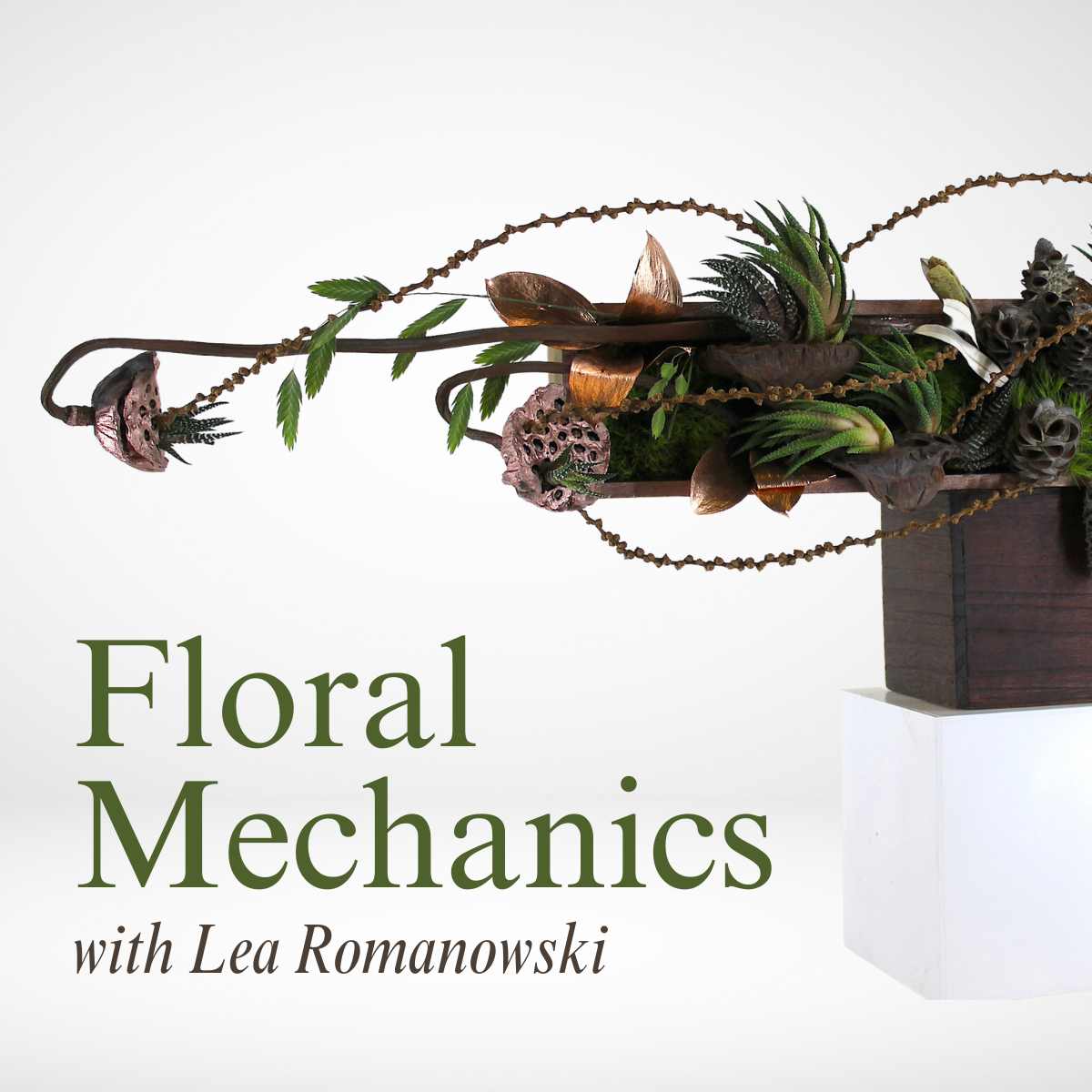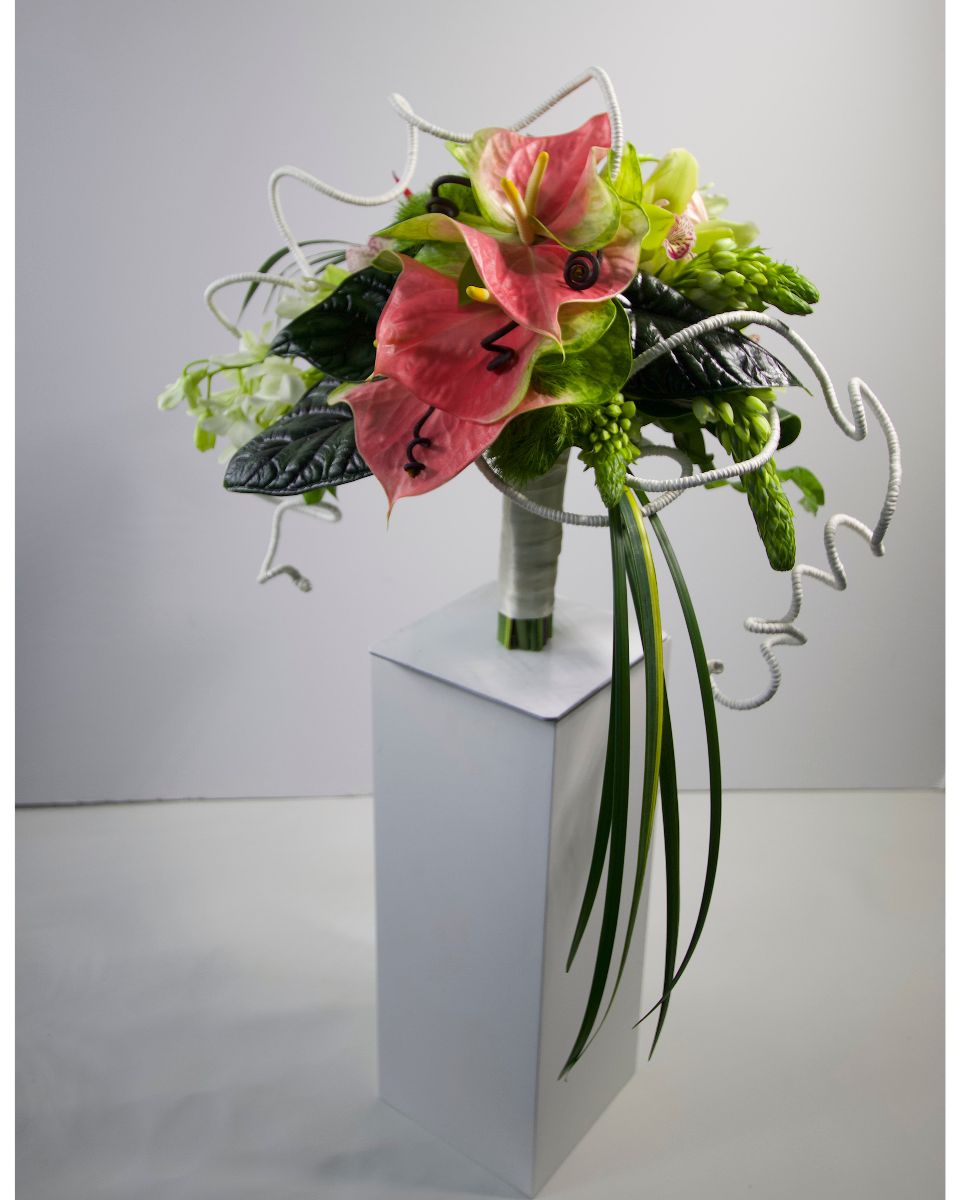


“Your foundation is the most critical part of anything you build,” says Canadian florist, Lea Romanowski CAFA, AIFD, CAFD. “If your foundation isn't good, if it isn't strong and true, it will affect the entire outcome of the design.”
Lea’s floral design work is beautifully crafted with precision design mechanics. During her 40+ plus years in flowers, Lea - owner of Designing on the Edge, has made an art of pushing the boundaries of design. Lea built the business using her carpentry, painting, metal work and electrical skills earning her the nickname "MacGyver, a fixer of all things visual."

Lea represented Canada at the 2023 Interflora World Cup in Manchester, England. Competing against elite floral artists from 19 nations. “There is no better place than World Cup, a three-day global floral event, to learn and compete at the same time," she suggests.
Lea enjoys seeing what designers from other countries come up with. Learning from their mechanics, their vision, their creativity. “Being there, I learned more about the world and about myself. It was fantastic.”
“And if you don't try, you never learn. You never get better. You never grow, and you're going to make mistakes, and that's okay because mistakes make us better at what we do and they keep us humble.”
The importance of floral mechanics
Lea has learned, through the years, the importance of excellent floral mechanics. Precision mechanics for everyday use, or evaluations and competitions, including AIFD’s PFDE.
“I think I learned to value mechanics early on in designing,” Lea explains. “I fell into this by accident.” She loved design and building things but planned to be an architect or paramedic. “I fell into the flower shop and never left. When a couple of things didn't work or fell apart, I realized how important stability is. It’s like building a house.”
“Your foundation is the most critical part of anything you build. And if your foundation isn't good, if your foundation isn't strong and true, it will affect the entire outcome of the design."
The potential for failure grows with the size of a design. If it's faulty, those faults expand as well. It starts at the foundation and works its way up. If your foundation is secure, the security expands as the design expands.”
Experience is the best teacher. Your toolbox is a combination of your experiences. “Even though sometimes it just feels terrible, I want to learn those lessons. You should be able to learn from a hard lesson the first time.”

“In my toolbox, I have is 41 years of experience.” Lea says.
- Failing at something.
- Learning a new technique.
- Having my time tested.
- Needing to work faster.
How can designers improve their mechanical skills?
In a previous blog, Michael Smith AIFD shared that when preparing for Sylvia Cup, he spent 30 minutes every afternoon after work trying a new design application. When that style was requested at Sylvia Cup, he was ready. He had been practicing.
“I listened to what Michael Smith said in his podcast, and to Jenny's podcast, and others. I would like to add to ‘being prepared and always trying new things.’ If you're preparing for a competition or you just want to be a better designer - you want to be faster or have a higher skill level, definitely try something new every week. Try a new technique. Learn that technique. Practice that technique. Become proficient at it.”

Invest in yourself
Invest in your own education. No one's going to do it for you. Lea had to self-educate in times when she couldn’t find educational opportunities. She suggests:
- Watching online videos.
- Buying books.
- Following step-by-step design instructions.
- Making mistakes and learning from them.
“Attend an online class of interesting new European techniques. Let's say, Gregor Lersch, Hitomi, or the Floos Network.” Continues Lea. “Search for in-person opportunities. Nothing can replace standing beside a teacher who helps by correcting you along the way.”
Once you've exhausted what’s available in your area, reach out:
- Attend a floral event.
- Hands-on classes.
- Design shows.
- Workshops.
- AIFD symposium.
As an instructor, Lea stresses the importance of mechanics. Designers need to know the rules before they decide to break them.
Why are mechanics important?
Why are mechanics important? Your mechanics will be tested by judges in competitive work. Lea experienced that at World Cup. A ‘Wave Design’ required participant’s interpretation of ocean waves. A dinner or table for two that incorporated some type of tabletop within size parameters. “Friends outside my booth saw my Wave Design being evaluated. Two judges shook my wave.”

When you send a design out to a home, it's going to be tested. By the delivery driver or the recipients who move it around in their home. It moves and shakes. If something falls apart, it means your foundation, your base was not well made.
Consider the abuse of a bridal bouquet. These mechanics are exceptionally important because each bouquet is handled so much.
In a Gateway to the America Cup competition, participants were instructed to design a bridal bouquet. The structural components could be created ahead of time. Lea made the mistake of putting the pieces together before arriving to the competition. She realized her error, went into the washroom, clipped apart the pieces, and brought them in, avoiding disqualification.
After taking the structure apart, Lea was unclear on exactly how the pieces went back together. She attached one component improperly and it became loose. “After judging, I saw a piece of the structure had fallen out. I was almost completely undone emotionally. Thankfully, I only had three marks total removed,” Lea says.
People think of competitions as glamorous, but they can also be humbling and stressful.
- It tests your talent.
- Your ability to think fast.
- Solve a problem.
- Develop an idea.
“It really grows you as a person and as a designer.”

You must know more than you’ve learned locally or in your country. For international competition, it’s important to be up to date on European design trends. “The European designers used more interesting color combinations and got higher marks,” she explains. Color is judged differently in Europe than in North America.
Lea studied all competitor’s marks for every category. She studied color - how people scored; why they got their score. She researched the European’s use color, finding it different from North Americans. Preparing for next time, she’s “educating myself, with Per Benjamin's book one and a couple of other resources on different ways to look at and creatively use color," Lea explains. “A lesson I needed to learn was to focus on the judging sheet.”
Race against the clock
Spur of the moment creative problem solving is another important lesson. Imagine that you are in a traditional flower shop, racing against the clock to get a design out. Or, in a competition and time is running out. You've got to work more quickly.
When people get nervous and behind the clock, in a shop or onstage, they often take shortcuts. Shortcuts can cause less sturdy designs. How can you refrain from taking shortcuts on mechanics? Managing your time is imperative.
Preparing for World Cup, Lea sought advice from European designer Neil Whitaker. He said, “break every design down into three parts of time”
- 1st third is foundation.
- 2nd third adding flowers and materials.
- Last third is finishing and checking your work.
This creates a plan to follow. A safety net when stressed.
People often think we carry our tools in a toolbox. Realistically, our greatest tools are how we approach the situation we're in. Not just in flowers, but in anything that we strive to do.
- Adaptability.
- Clear thought and purpose.
- Problem solving skills.
- Knowing how to manage competition.
- Ready with a back-up plan.
- Maintaining control.
“In competitive design, the biggest mistake a designer can make is to show every tool or trick you have in one design,” says Lea. “Show only two or three amazing techniques.” Resist doing extra because the more you do, the more opportunities you have to lose points. Keep it simple.
When a mechanic fails, learn from the experience. Maintain a good attitude. A positive attitude will always keep you moving forward. A negative attitude won’t help when you need to solve a problem. “There are no problems.
There are only solutions," adds Lea. “Experience trumps talent.”
The more we experience, the more successful we are in times of crisis. Expanding is fun. When something is fun, we relax and are more willing to face challenge.
Procuring materials
A big challenge is procurement. Competitors have always known they were never going to get everything on their list. Lea’s World Cup fresh order was only 80% confirmed due to supply issues. When facing supply issues:
- Think on your feet.
- Change concepts.
- Make a new plan on the spot.
- Lean on your experience.
If you can't get the flowers you want, use the flowers you get. Sometimes that's difficult.
During World Cup, Lea visited the wholesalers and was pleased with their product. Except for one design. They couldn’t guarantee the materials needed. She asked for available options, creatively juggled her materials, took material from other projects, and created a new plan.
When procuring flowers globally you may experience time differences and language barriers. It’s important to have a backup plan and a list of substitutions. Visit the suppliers, check your order, add or subtract as needed. If things are missing, this is where your ‘toolbox’ comes in.
"When you think you are prepared, think again. Not everything is in your control. When you do have control, play to your strengths.”
Securing mechanics
“Personally, I love natural mechanics,” Lea confides. “If I can, I use the compression technique. It's very secure. When using a branch in a container with the compression technique, I know it will hold in place. It’s going to be judged higher because it’s a natural mechanic.”
Cut a branch slightly larger than the vase interior and gently force it into the container. Creating natural compartments to design in. “It’s a stable, very clean, natural look.”
Lea also enjoys weaving and braiding things and designing through the materials. She excels at using leaf manipulation for creative flair. “I like to make a statement using a container and materials, not as intended, but something completely unexpected.” She chooses the best mechanic for security - such as Oasis wire, bullion, UGlu, or florist wire.
The goal in competition is a design that’s well-made, features techniques, mechanics, and elements used in a different way to showcase your design skill. “I must say Oasis UGlu strips have often saved my life. At World Cup, I used two and a half boxes,” Lea confides.
“Take the time to educate yourself. Invest in yourself, your future, your design abilities.”
The goal of design, is to learn to share your love of flowers and design with the world - while making a profit. It's not just a hobby, it’s a career, a passion, a life. For competitive designers, Lea suggests “we do design work to pay our bills, but we compete for the delight of our soul.”
